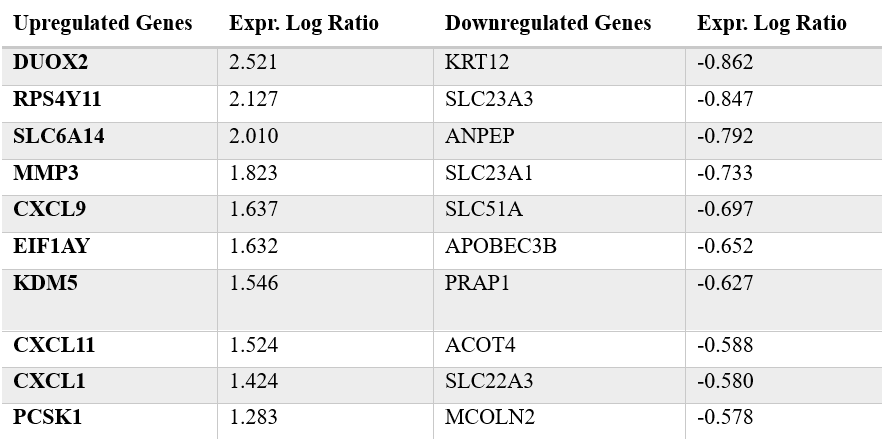Gastroenterology/Hepatology
Session: Gastroenterology/Hepatology
326 - Genetic Distinctions in Pediatric Crohn’s Disease: Diagnostic and Therapeutic Implications
Sunday, April 27, 2025
8:30am - 10:45am HST
Publication Number: 326.4646
Stephanie A. Sutton, University of Central Florida College of Medicine, ocala, FL, United States; Sarah Voskamp, University of Central Florida College of Medicine, Orlando, FL, United States; Pablo Palomo, Nemours Children's Hospital, Orlando, FL, United States; Jennifer S. Nelson, University of Central Florida College of Medicine, Orlando, FL, United States

Stephanie A. Sutton, MPH (she/her/hers)
Medical Student
University of Central Florida College of Medicine
ocala, Florida, United States
Presenting Author(s)
Background: Crohn’s disease (CD) is a chronic inflammatory bowel disease marked by transmural inflammation, which can cause significant morbidity if not adequately managed. Pediatric-onset Crohn’s disease often presents with a more aggressive disease course, greater genetic burden, and distinct genetic changes compared to adults. Given the potentially progressive and destructive nature of the disease, further elucidating differences between these two populations is essential.
Objective: This study investigates key genetic variations in pediatric CD which may contribute to pathogenesis, diagnostic biomarkers, or therapeutic targets.
Design/Methods: 52 pediatric Crohn’s disease samples and 24 pediatric healthy intestinal samples were identified via the Search Tag Analyze Resource for NCBI’s Gene Expression Omnibus (STARGEO). Ingenuity Pathway Analysis (IPA) was utilized to explore biological relationships between differentially expressed genes. All genes were restricted to p< 0.05 and absolute experimental log ratio of 0.2.
Results: Pediatric Crohn’s disease samples had a striking 1961 differentially expressed genes compared to healthy intestinal tissue. Top upregulated genes include DUOX2, SLC6A14, MMP3, and CXCL1. These genes are involved in thyroid hormone synthesis, neurotransmitter transport, tissue remodeling, inflammation, and chemotaxis of neutrophils, among many other vital functions of the upregulated genes. Downregulated genes such as SLC23A3, ANPEP, and SLC23A1, are involved in transmembrane transport, peptide digestion in the small intestine, and absorption of vitamin C. The top canonical pathways that are differentially regulated in pediatric CD include neutrophil degranulation, pathogen induced cytokine storm signaling pathway, granulocyte adhesion and diapedesis, hepatic fibrosis/hepatic stellate cell activation, and agranulocyte adhesion and diapedesis. The top upstream regulators are TNF, dexamethasone, lipopolysaccharide, TGFB1, and IFNG.
Conclusion(s): Overall, genes involved in the inflammatory process are upregulated in pediatric CD whereas genes involved in the physiological function of the intestines are downregulated. Identifying genetic signatures associated with Crohn’s disease and differences that may be present in the pediatric population will help guide treatment regimens for different age groups. The predicted upstream regulators and causal networks enable identification of potential therapeutic drugs and the downstream effect. Furthermore, we highlight associated pathways and biological functions to elucidate the pathogenesis of pediatric Crohn’s disease.
Gene Candidates
 The top 10 up and down regulated genes for pediatric Crohn’s disease. Experimental log ratio indicates the magnitude and direction of change compared to healthy intestinal tissue.
The top 10 up and down regulated genes for pediatric Crohn’s disease. Experimental log ratio indicates the magnitude and direction of change compared to healthy intestinal tissue.Graphical Summary
 Graphical summary of pediatric Crohn’s disease providing overview of biological themes and connecting the most significant predictions.
Graphical summary of pediatric Crohn’s disease providing overview of biological themes and connecting the most significant predictions.Downstream Effects of Upstream Regulator TNF
 Downstream effects of upstream regulator TNF, predicted activation with z-score 11.195. The ten most a) upregulated or b) downregulated genes impacted by the predicted activation of TNF are overlaid in the figure. Gene candidates that are also impacted by TNF include DUOX2, MMP3, CXCL9, CXCL11, CXCL1, ANPEP, APOBEC3B, and SLC22A3.
Downstream effects of upstream regulator TNF, predicted activation with z-score 11.195. The ten most a) upregulated or b) downregulated genes impacted by the predicted activation of TNF are overlaid in the figure. Gene candidates that are also impacted by TNF include DUOX2, MMP3, CXCL9, CXCL11, CXCL1, ANPEP, APOBEC3B, and SLC22A3.Gene Candidates
 The top 10 up and down regulated genes for pediatric Crohn’s disease. Experimental log ratio indicates the magnitude and direction of change compared to healthy intestinal tissue.
The top 10 up and down regulated genes for pediatric Crohn’s disease. Experimental log ratio indicates the magnitude and direction of change compared to healthy intestinal tissue.Graphical Summary
 Graphical summary of pediatric Crohn’s disease providing overview of biological themes and connecting the most significant predictions.
Graphical summary of pediatric Crohn’s disease providing overview of biological themes and connecting the most significant predictions.Downstream Effects of Upstream Regulator TNF
 Downstream effects of upstream regulator TNF, predicted activation with z-score 11.195. The ten most a) upregulated or b) downregulated genes impacted by the predicted activation of TNF are overlaid in the figure. Gene candidates that are also impacted by TNF include DUOX2, MMP3, CXCL9, CXCL11, CXCL1, ANPEP, APOBEC3B, and SLC22A3.
Downstream effects of upstream regulator TNF, predicted activation with z-score 11.195. The ten most a) upregulated or b) downregulated genes impacted by the predicted activation of TNF are overlaid in the figure. Gene candidates that are also impacted by TNF include DUOX2, MMP3, CXCL9, CXCL11, CXCL1, ANPEP, APOBEC3B, and SLC22A3.
